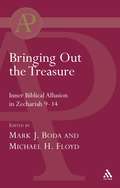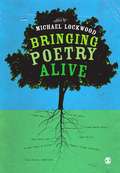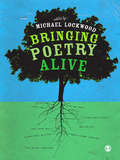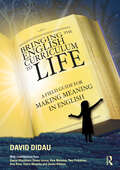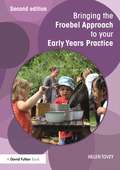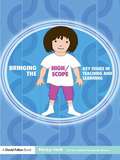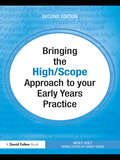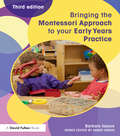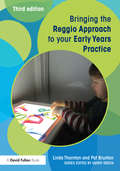- Table View
- List View
Bringing Out the Algebraic Character of Arithmetic: From Children's Ideas To Classroom Practice (Studies In Mathematical Thinking And Learning Ser.)
by Analucia D. SchliemannBringing Out the Algebraic Character of Arithmetic contributes to a growing body of research relevant to efforts to make algebra an integral part of early mathematics instruction, an area of studies that has come to be known as Early Algebra. It provides both a rationale for promoting algebraic reasoning in the elementary school curriculum and empi
Bringing Out the Treasure: Inner Biblical Allusion in Zechariah 9-14 (The Library of Hebrew Bible/Old Testament Studies)
by Mark J. Boda Michael FloydIt is generally agreed within Hebrew Bible scholarship that Zechariah 9-14 is filled with allusions to other books within the Hebrew canon. Rex Mason's doctoral dissertation in the early 1970s contributed significantly to the foundation of this consensus. However, although Mason's thesis remains a seminal work for those studying Deutero-Zechariah, it has never been published. This volume contains the first publication of that work together with reflections from leading biblical scholars who have published onZechariah 9-14. The volume is rounded off with a response by Mason to these scholars and a reflection on his own contribution thirty years ago.Journal for the Study of the Old Testament Supplement series, Volume 370.
Bringing Poetry Alive: A Guide to Classroom Practice (PDF)
by Michael LockwoodOffering a wealth of ideas and support for ways to really bring poetry alive, this book draws on what is known to work, and explores fresh thinking. It will help both new and experienced teachers approach poetry with imagination and confidence. Written by people who have taught poetry in different settings for many years, and with contributions from poets Michael Rosen and James Carter, this book offers ideas on: - using drama - cross-curricular working - what to do with younger learners - inspiring children to write their own poems - and much more … An enjoyable and uplifting book, it is a must for anyone working with children aged 5 to 14 who is looking for inspiration for their poetry teaching. Michael Lockwood is Senior Lecturer in English and Education, University of Reading.
Bringing Poetry Alive: A Guide to Classroom Practice
by Michael LockwoodOffering a wealth of ideas and support for ways to really bring poetry alive, this book draws on what is known to work, and explores fresh thinking. It will help both new and experienced teachers approach poetry with imagination and confidence. Written by people who have taught poetry in different settings for many years, and with contributions from poets Michael Rosen and James Carter, this book offers ideas on: - using drama - cross-curricular working - what to do with younger learners - inspiring children to write their own poems - and much more … An enjoyable and uplifting book, it is a must for anyone working with children aged 5 to 14 who is looking for inspiration for their poetry teaching. Michael Lockwood is Senior Lecturer in English and Education, University of Reading.
Bringing Schools into the 21st Century (Explorations of Educational Purpose #13)
by Guofang Wan and Dianne M. GutShift happens: Emerging technologies and globalization have resulted in political, social and cultural changes. These changes have a profound impact on all aspects of human life, including education. Yet while society has changed and continues to change, schools are slow to keep up. This book explores issues related to transforming and modernizing our educational systems, including the impact of societal shifts on education, the efforts at various levels to bring schools into the 21st century, the identification of 21st century skills, the reformation of the curriculum, the creation of alternative models of schooling, the innovative use of technology in education, and many others. It addresses questions like the following: Should schools systems adapt to better meet the needs of tomorrow’s world and how should this be accomplished? How can society better prepare students for a changing and challenging modern world? What skills do students need to lead successful lives and become productive citizens in the 21st century? How can educators create learning environments that are relevant and meaningful for digital natives? How can the school curriculum be made more rigorous to meet the needs of the 21st century? This book encourages readers to transcend the limits of their own educational experience, to think beyond familiar notions of schooling, instruction and curriculum, to consider how to best structure learning so that it will benefit future generations. It encourages a deeper analysis of the existing education system and offers practical insights into future directions focused on preparing students with 21st century skills.
Bringing Spanish to Life: Creative activities for 5-11
by Catherine Watts Hilary PhillipsBringing Spanish to Life provides an innovative and refreshing cross-curricular approach to teaching languages in primary schools, combining art, design and foreign languages with various aspects of the National Primary Curriculum such as Literacy, Numeracy and PE. This unique practical resource comprises an engaging storyline about a day in the life of two Spanish children and gives an opportunity for learners to re-enact their day, using finger puppets, handmade crafts and exciting games to practise new language. Each of the 14 sections begins with a short accessible dialogue in Spanish and is followed by suggestions for using the new vocabulary in pairs, small groups or as a whole class. The main story is accompanied by fun craft activities linked to the story (one for each section, ie 14 in total) for children to create in class using the templates and instructions provided. A wide range of further activities follows, consisting of lively games, songs and opportunities to communicate simple ideas. Language extensions are suggested, focussing on imaginative writing and reading ideas linked to the theme of each section. Written to support the new foreign languages programme of study, the book also includes: * Cross-curricular links to numerous subjects including Literacy, Numeracy, PE and ICT * Classroom games and activities * Photocopiable resources and templates for fun classroom activities and projects * Language extension activities. Bringing Spanish to Life can be read on three levels to suit a variety of classroom situations. First, the story can be told ‘straight’ with the whole class participating in the dialogues. Second, the story can be combined with the craft activities after each main section. 14 doing and making activities match the storyline and provide a colourful, eye catching display and learning focus in the classroom or for Open Days or Assemblies. Teachers can use as many or as few as they wish. The resultant crafts can be used for very effective classroom displays/open days/assemblies etc. Finally, the language extension activities can be used alongside the art/craft/design activities as desired. The aim of these activities is to extend the target language in a relevant context through a variety of methods such as songs, playlets, simple communicative exchanges, games with numbers etc.
Bringing Spanish to Life: Creative activities for 5-11
by Catherine Watts Hilary PhillipsBringing Spanish to Life provides an innovative and refreshing cross-curricular approach to teaching languages in primary schools, combining art, design and foreign languages with various aspects of the National Primary Curriculum such as Literacy, Numeracy and PE. This unique practical resource comprises an engaging storyline about a day in the life of two Spanish children and gives an opportunity for learners to re-enact their day, using finger puppets, handmade crafts and exciting games to practise new language. Each of the 14 sections begins with a short accessible dialogue in Spanish and is followed by suggestions for using the new vocabulary in pairs, small groups or as a whole class. The main story is accompanied by fun craft activities linked to the story (one for each section, ie 14 in total) for children to create in class using the templates and instructions provided. A wide range of further activities follows, consisting of lively games, songs and opportunities to communicate simple ideas. Language extensions are suggested, focussing on imaginative writing and reading ideas linked to the theme of each section. Written to support the new foreign languages programme of study, the book also includes: * Cross-curricular links to numerous subjects including Literacy, Numeracy, PE and ICT * Classroom games and activities * Photocopiable resources and templates for fun classroom activities and projects * Language extension activities. Bringing Spanish to Life can be read on three levels to suit a variety of classroom situations. First, the story can be told ‘straight’ with the whole class participating in the dialogues. Second, the story can be combined with the craft activities after each main section. 14 doing and making activities match the storyline and provide a colourful, eye catching display and learning focus in the classroom or for Open Days or Assemblies. Teachers can use as many or as few as they wish. The resultant crafts can be used for very effective classroom displays/open days/assemblies etc. Finally, the language extension activities can be used alongside the art/craft/design activities as desired. The aim of these activities is to extend the target language in a relevant context through a variety of methods such as songs, playlets, simple communicative exchanges, games with numbers etc.
Bringing the Common Core Math Standards to Life: Exemplary Practices from Middle Schools
by Yvelyne Germain-McCarthyAs middle school math teachers shift to the Common Core State Standards, the question remains: What do the standards actually look like in the classroom? This book answers that question by taking you inside of real, Common Core classrooms across the country. You’ll see how exemplary teachers are meeting the new requirements and engaging students in math. Through these detailed examples of effective instruction, you will uncover how to bring the standards to life in your own classroom! Special Features:• A clear explanation of the big shifts happening in the classroom as a result of the Common Core State Standards • Real examples of how exemplary teachers are meeting the CCSS by teaching problem solving for different learning styles, proportional reasoning, the Pythagorean theorem, measurements, and more• A detailed analysis of each example to help you understand why it is effective and how you can try it with your own students• Practical, ready-to-use tools you can take back to your classroom, including unit plans and classroom handouts
Bringing the Common Core Math Standards to Life: Exemplary Practices from Middle Schools
by Yvelyne Germain-McCarthyAs middle school math teachers shift to the Common Core State Standards, the question remains: What do the standards actually look like in the classroom? This book answers that question by taking you inside of real, Common Core classrooms across the country. You’ll see how exemplary teachers are meeting the new requirements and engaging students in math. Through these detailed examples of effective instruction, you will uncover how to bring the standards to life in your own classroom! Special Features:• A clear explanation of the big shifts happening in the classroom as a result of the Common Core State Standards • Real examples of how exemplary teachers are meeting the CCSS by teaching problem solving for different learning styles, proportional reasoning, the Pythagorean theorem, measurements, and more• A detailed analysis of each example to help you understand why it is effective and how you can try it with your own students• Practical, ready-to-use tools you can take back to your classroom, including unit plans and classroom handouts
Bringing the Common Core Math Standards to Life: Exemplary Practices from High Schools
by Yvelyne Germain-McCarthy Ivan GillAs high school math teachers shift to the Common Core State Standards, the question remains: What do the standards actually look like in the classroom? This book answers that question by taking you inside of real Common Core classrooms across the country. You’ll see how exemplary teachers are meeting the new requirements and engaging students in math. Through these detailed examples of effective instruction, you will uncover how to bring the standards to life in your own classroom! Special Features: A clear explanation of the big shifts happening in the classroom as a result of the Common Core State Standards Real examples of how exemplary teachers are using engaging strategies and tasks to teach algebra, geometry, trigonometry, statistics, mathematics across the curriculum, and moreA detailed analysis of each example to help you understand why it is effective and how you can try it with your own students Practical, ready-to-use tools you can take back to your classroom, including unit plans and classroom handouts
Bringing the Common Core Math Standards to Life: Exemplary Practices from High Schools
by Yvelyne Germain-McCarthy Ivan GillAs high school math teachers shift to the Common Core State Standards, the question remains: What do the standards actually look like in the classroom? This book answers that question by taking you inside of real Common Core classrooms across the country. You’ll see how exemplary teachers are meeting the new requirements and engaging students in math. Through these detailed examples of effective instruction, you will uncover how to bring the standards to life in your own classroom! Special Features: A clear explanation of the big shifts happening in the classroom as a result of the Common Core State Standards Real examples of how exemplary teachers are using engaging strategies and tasks to teach algebra, geometry, trigonometry, statistics, mathematics across the curriculum, and moreA detailed analysis of each example to help you understand why it is effective and how you can try it with your own students Practical, ready-to-use tools you can take back to your classroom, including unit plans and classroom handouts
Bringing the English Curriculum to Life: A Field Guide for Making Meaning in English
by David DidauBringing the English Curriculum to Life builds on David Didau’s groundbreaking book Making Meaning in English by showing how the principles of the original book can be applied in schools and classrooms. Drawing together experiences of designing, teaching, supporting and assessing English across the schools within Ormiston Academies Trust (OAT), this book demonstrates what an ambitious, coherently sequenced, broad and balanced English curriculum with successful adaption for students with SEND can look like in practice.Designed around the explicit teaching of the powerful conceptual knowledge students need to master the discipline, the book offers a fully resourced English curriculum packed with teaching suggestions and examples of high-quality practice. Covering intent, implementation and assessment, and outlining in detail what is included in each module for KS3 and 4, the curriculum can be adopted in its entirety, but is also flexible enough for departments to take modules and slot them into their own curriculum.Providing an inspiring model for teaching English that enables all students to succeed, this is an essential resource for all English teachers and school leaders responsible for curriculum development.
Bringing the English Curriculum to Life: A Field Guide for Making Meaning in English
by David DidauBringing the English Curriculum to Life builds on David Didau’s groundbreaking book Making Meaning in English by showing how the principles of the original book can be applied in schools and classrooms. Drawing together experiences of designing, teaching, supporting and assessing English across the schools within Ormiston Academies Trust (OAT), this book demonstrates what an ambitious, coherently sequenced, broad and balanced English curriculum with successful adaption for students with SEND can look like in practice.Designed around the explicit teaching of the powerful conceptual knowledge students need to master the discipline, the book offers a fully resourced English curriculum packed with teaching suggestions and examples of high-quality practice. Covering intent, implementation and assessment, and outlining in detail what is included in each module for KS3 and 4, the curriculum can be adopted in its entirety, but is also flexible enough for departments to take modules and slot them into their own curriculum.Providing an inspiring model for teaching English that enables all students to succeed, this is an essential resource for all English teachers and school leaders responsible for curriculum development.
Bringing the Forest School Approach to your Early Years Practice (Bringing ... to your Early Years Practice)
by Karen ConstableThis easy-to-read series provides an introduction to some of the most important early years philosophies and shows how they can be incorporated into your setting. Each book provides: an outline of the background to the approach clear explanations of the relevance to contemporary thinking suggestions to help you plan a successful learning environment examples of what the individual approach can look like in practice. These convenient guides are essential to early years practitioners, students and parents who wish to fully understand what each approach means to their setting and children. How has Forest School helped to change attitudes about risk and challenge in the early years? What are the benefits of using this approach for children’s development, health and overall wellbeing? Bringing the Forest School Approach to your Early Years Practice provides an accessible introduction to Forest School practice. It identifies the key issues involved in setting up, running and managing a Forest school environment and offers clear guidance on resources, staffing and space required for successful play and learning outdoors. Including links to the Early Years Foundation Stage and a wide range of case studies, the book covers: The beginnings of Forest School and how practice has developed Child centred play and learning that allows for risk taking and challenge Planning for children’s individual needs, learning styles and schemas The learning environment The role of the adult including health and safety and children’s welfare. Full of practical advice, this convenient guide will help practitioners to deliver new, exciting and inspiring opportunities for the children they care for.
Bringing the Forest School Approach to your Early Years Practice (Bringing ... to your Early Years Practice)
by Karen ConstableThis easy-to-read series provides an introduction to some of the most important early years philosophies and shows how they can be incorporated into your setting. Each book provides: an outline of the background to the approach clear explanations of the relevance to contemporary thinking suggestions to help you plan a successful learning environment examples of what the individual approach can look like in practice. These convenient guides are essential to early years practitioners, students and parents who wish to fully understand what each approach means to their setting and children. How has Forest School helped to change attitudes about risk and challenge in the early years? What are the benefits of using this approach for children’s development, health and overall wellbeing? Bringing the Forest School Approach to your Early Years Practice provides an accessible introduction to Forest School practice. It identifies the key issues involved in setting up, running and managing a Forest school environment and offers clear guidance on resources, staffing and space required for successful play and learning outdoors. Including links to the Early Years Foundation Stage and a wide range of case studies, the book covers: The beginnings of Forest School and how practice has developed Child centred play and learning that allows for risk taking and challenge Planning for children’s individual needs, learning styles and schemas The learning environment The role of the adult including health and safety and children’s welfare. Full of practical advice, this convenient guide will help practitioners to deliver new, exciting and inspiring opportunities for the children they care for.
Bringing the Froebel Approach to your Early Years Practice (Bringing ... to your Early Years Practice)
by Helen ToveyHave you ever wondered about the origins of the kindergarten and the influence of Froebel on early years practice? What did Froebel mean by a garden for children? Why did he believe that play is central in young children’s learning? Bringing the Froebel Approach to your Early Years Practice looks at the founder of the kindergarten and his profound influence on provision and practice for young children today. The Froebelian approach is not a method but includes distinctive principles which shape and guide practice. This new edition has been fully updated in line with the revised EYFS and includes: extra material on using the approach with children of different ages and the role of the adult a discussion of key Froebelian principles such as play, imagination, creativity, learning through self-activity and making connections an examination of block play and how this can be developed in contemporary settings Froebel’s ideas on nature and outdoor play and why these are fundamental to young children’s learning how Froebel used movement, song, rhythm and rhyme to provide key learning experiences With examples of innovative practice and ideas for reflection, this convenient guide will help practitioners and students fully understand what the Froebel approach can offer their setting and children.
Bringing the Froebel Approach to your Early Years Practice (Bringing ... to your Early Years Practice)
by Helen ToveyHave you ever wondered about the origins of the kindergarten and the influence of Froebel on early years practice? What did Froebel mean by a garden for children? Why did he believe that play is central in young children’s learning? Bringing the Froebel Approach to your Early Years Practice looks at the founder of the kindergarten and his profound influence on provision and practice for young children today. The Froebelian approach is not a method but includes distinctive principles which shape and guide practice. This new edition has been fully updated in line with the revised EYFS and includes: extra material on using the approach with children of different ages and the role of the adult a discussion of key Froebelian principles such as play, imagination, creativity, learning through self-activity and making connections an examination of block play and how this can be developed in contemporary settings Froebel’s ideas on nature and outdoor play and why these are fundamental to young children’s learning how Froebel used movement, song, rhythm and rhyme to provide key learning experiences With examples of innovative practice and ideas for reflection, this convenient guide will help practitioners and students fully understand what the Froebel approach can offer their setting and children.
Bringing the High/Scope Approach to your Early Years Practice
by Nicky HoltHave you ever wondered what High/Scope is, where it came from, and how it can be used with young children in your setting? This book will answer all your questions and more. It includes: details about the High/Scope Wheel of Learning an explanation of Active Learning, including materials, manipulation, choice, language and support Plan-Do-Review activities planning and assessment methods.
Bringing the High Scope Approach to your Early Years Practice (Bringing ... to your Early Years Practice)
by Nicky HoltHave you ever wondered what High/Scope is, where it came from, and how it can be used with young children in your setting? Bringing the High Scope Approach to your Early Years Practice provides an introduction to the High/Scope philosophy and its use in early years. This new edition has been fully updated to show how the High/Scope approach links with the Early Years Foundation Stage and contains new material on working with the under twos. Features include: details about the High/Scope Wheel of Learning an explanation of Active Learning, including materials, manipulation, choice, language and support Plan-Do-Review activities planning and assessment methods. This convenient guide will help Early Years practitioners, students and parents to really understand what the High/Scope approach can offer their setting and children.
Bringing the High Scope Approach to your Early Years Practice (Bringing ... to your Early Years Practice)
by Nicky HoltHave you ever wondered what High/Scope is, where it came from, and how it can be used with young children in your setting? Bringing the High Scope Approach to your Early Years Practice provides an introduction to the High/Scope philosophy and its use in early years. This new edition has been fully updated to show how the High/Scope approach links with the Early Years Foundation Stage and contains new material on working with the under twos. Features include: details about the High/Scope Wheel of Learning an explanation of Active Learning, including materials, manipulation, choice, language and support Plan-Do-Review activities planning and assessment methods. This convenient guide will help Early Years practitioners, students and parents to really understand what the High/Scope approach can offer their setting and children.
Bringing the High/Scope Approach to Your Early Years Practice (PDF)
by Nicky HoltHave you ever wondered what High/Scope is, where it came from, and how it can be used with young children in your setting? This book will answer all your questions and more. It includes: details about the High/Scope Wheel of Learning an explanation of Active Learning, including materials, manipulation, choice, language and support Plan-Do-Review activities planning and assessment methods.
Bringing the Montessori Approach to your Early Years Practice (Bringing ... to your Early Years Practice)
by Barbara IsaacsHave you ever wondered what the Montessori approach is all about and how it can be used to benefit the young children in your setting? This book explains how the Montessori approach works offering guidance on planning and assessment methods alongside practical activities for practitioners to try. Throughout there are practical examples involving children of different ages in a wide range of settings to show how Montessori principles have been implemented. . This new edition has been fully updated to include: The revised areas of learning in the EYFS and how these link to Montessori practice An examination of early effective learning Approaches to effective learning in Montessori settings A new chapter on Montessori approaches to the assessment requirements of the EYFSquestions for reflection This convenient guide will help early years practitioners, students and parents to really understand what the Montessori approach means to their setting and children.
Bringing the Montessori Approach to your Early Years Practice (Bringing ... to your Early Years Practice)
by Barbara IsaacsHave you ever wondered what the Montessori approach is all about and how it can be used to benefit the young children in your setting? This book explains how the Montessori approach works offering guidance on planning and assessment methods alongside practical activities for practitioners to try. Throughout there are practical examples involving children of different ages in a wide range of settings to show how Montessori principles have been implemented. . This new edition has been fully updated to include: The revised areas of learning in the EYFS and how these link to Montessori practice An examination of early effective learning Approaches to effective learning in Montessori settings A new chapter on Montessori approaches to the assessment requirements of the EYFSquestions for reflection This convenient guide will help early years practitioners, students and parents to really understand what the Montessori approach means to their setting and children.
Bringing the Reggio Approach to your Early Years Practice (Bringing ... to your Early Years Practice)
by Linda Thornton Pat BruntonHave you ever wondered what the Reggio Approach is all about, why it works, and how it can be used to benefit the young children in your setting? The book describes how educators in Reggio Emilia work with young children, and looks at the connections between the Reggio Approach and the revised Early Years Foundation Stage framework. It provides practical examples involving children of different ages in a wide variety of settings, helping the reader to see the connection between practice and theory. This new edition has been fully updated to show the increasingly mirroring connections between the Reggio Approach and the principles and commitments of the recently revised Early Years Foundation Stage (EYFS) framework. Each chapter focuses on one important aspect of the Reggio Approach and includes: Practical examples involving children of different ages in a wide variety of settings, helping the reader to see the connection between practice and theory Questions to enable the reader to reflect on and develop his or her own practice in accordance with new statutory requirements References to sources of further reading and information. This convenient guide will help early years practitioners, students and parents to really understand what the Reggio Approach can offer their setting and children.
Bringing the Reggio Approach to your Early Years Practice (Bringing ... to your Early Years Practice)
by Linda Thornton Pat BruntonHave you ever wondered what the Reggio Approach is all about, why it works, and how it can be used to benefit the young children in your setting? The book describes how educators in Reggio Emilia work with young children, and looks at the connections between the Reggio Approach and the revised Early Years Foundation Stage framework. It provides practical examples involving children of different ages in a wide variety of settings, helping the reader to see the connection between practice and theory. This new edition has been fully updated to show the increasingly mirroring connections between the Reggio Approach and the principles and commitments of the recently revised Early Years Foundation Stage (EYFS) framework. Each chapter focuses on one important aspect of the Reggio Approach and includes: Practical examples involving children of different ages in a wide variety of settings, helping the reader to see the connection between practice and theory Questions to enable the reader to reflect on and develop his or her own practice in accordance with new statutory requirements References to sources of further reading and information. This convenient guide will help early years practitioners, students and parents to really understand what the Reggio Approach can offer their setting and children.

